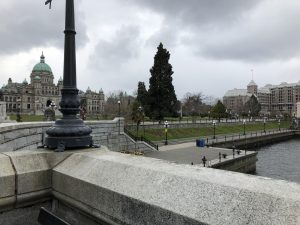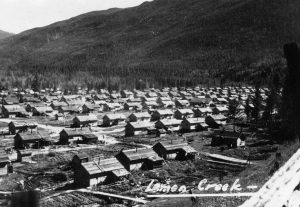Freedom or safety Lessons from internment to COVID-19
Freedom or Safety: Lessons from Japanese Canadian Internment to COVID-19
Zoë-Blue Coates
We are in a global pandemic. With social distancing in place, COVID-19 has changed the day to day of all Canadians in a way not seen since the world wars. Our economy and citizens are dedicating their time to fight a virus that could cause irrevocable damage if we do not take the necessary precautions.
Usually bustling with tourists, downtown Victoria is deserted due to social distancing. Photo: Michael Abe
As a history student and research assistant on Landscapes of Injustice, I am curious of what parallels can be drawn between the past and the challenges we currently face as we live in this historic moment. Evidently, a common thread between the history of Japanese Canadian internment and the COVID-19 pandemic is whether our collective responsibility to our fellow Canadians presently and going forward outweighs our individual rights to freedom, and who has the authority to tell us that it is our responsibility. The use of the War Measures Act enacted to intern Japanese Canadians, Germans, Italians, and Jewish refugees of German and Austrian descent during WWII mirrors the ways that law enforcement is being used around the world to ensure that people follow social distancing. The municipal government of Vancouver has declared a state of emergency and amended a by-law to fine up to $50,000 for those who fail to comply. This bill has not yet been enacted, but given that Vancouver is the most expensive city in Canada it is likely that this state of emergency will disproportionately affect marginalized communities like the homeless and drug users on the Downtown Eastside. These communities rely on gathering at safe injection sites to keep from overdosing in isolation as we have seen in this Opioid epidemic whereby 439 drug related deaths were reported in 2018 by Vancouver Coastal Health.
Lemon Creek Internment Site Photo: Nikkei National Museum & Cultural Centre.1994.60.11
In the case of Japanese Canadian internment, the Special Committee on Orientals in British Columbia shared a report and recommendations on Japanese and Chinese Canadian populations in British Columbia in December of 1940. Summary point 44 argued that the committee was concerned anti-Japanese sentiments in White-Canadian communities would result in riots. The concern over anti-Japanese riots combined with fear of the resources needed to protect the country from Japanese loyalty can be seen as a factor in the internment of all persons of Japanese origin. While the Canadian government allegedly interned Japanese Canadians for their individual safety and the collective safety of all Canadians, they did so through the seizure of land, private property, monetary funds and interruption of civil rights.
Unlike Japanese Canadian internment, social distancing is being used for the collective safety and health of all Canadians regardless of their race or nationality, but these measures can have a disproportionate impact. History has shown that internment was used as a tool that hindered the freedom and safety of some for the freedom and safety of all Canadians. Similarly, marginalized people who rely on foodbanks, shelters, and safe injection sites are having to sacrifice their freedom and safety as facilities that keep them alive close to meet the criteria of social distancing. As we continue to stay home to keep COVID-19 at bay and avoid overloading our healthcare system; it is essential that we not take the roofs over our heads for granted, nor the food and supplies that we have in our homes. Our freedom and safety is a privilege that often comes at the expense of others.
Zoë-Blue Coates is a fifth year undergraduate student at the University of Victoria studying history and Indigenous studies. Her main focus is on history in Canada and the ways that the public learns about lesser known events like Japanese Canadian internment. As a work study student Zoë-Blue worked on the family research case files to ensure that the Japanese Canadian community can learn about their family’s past.




